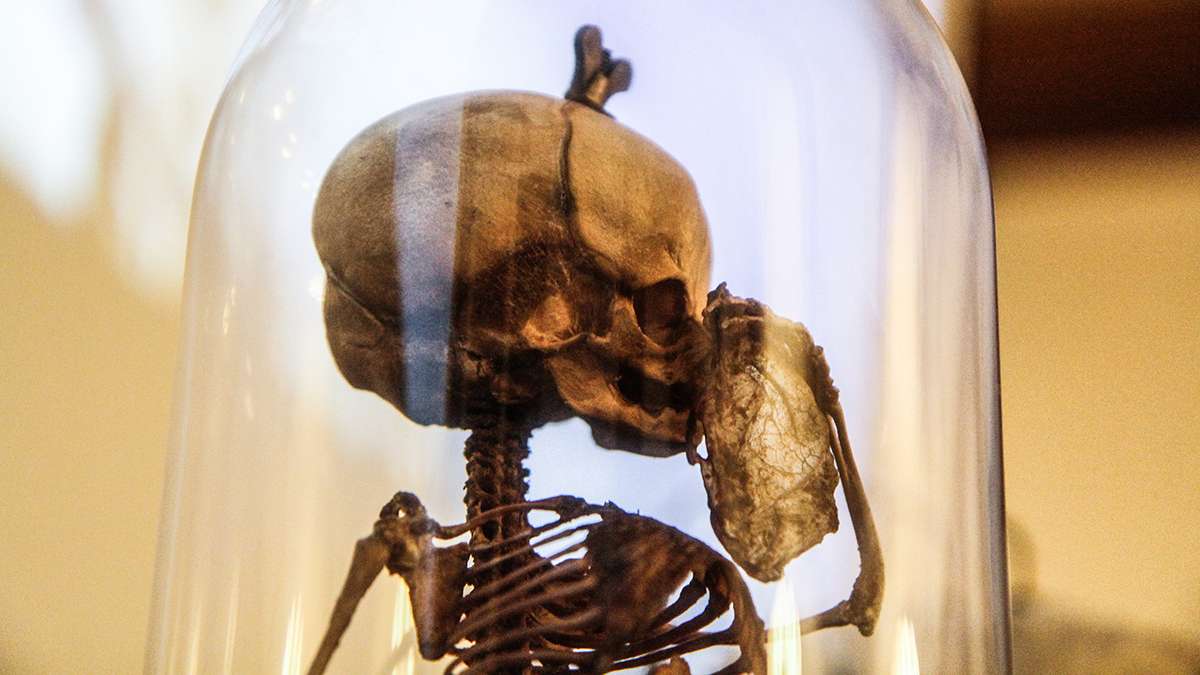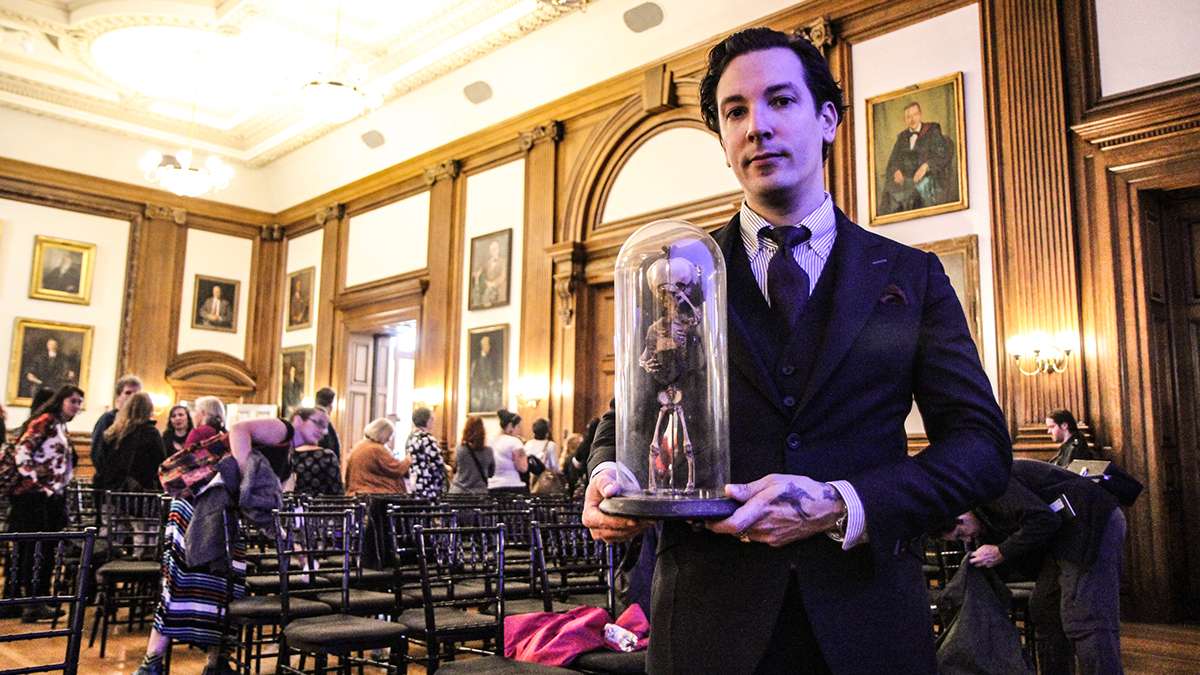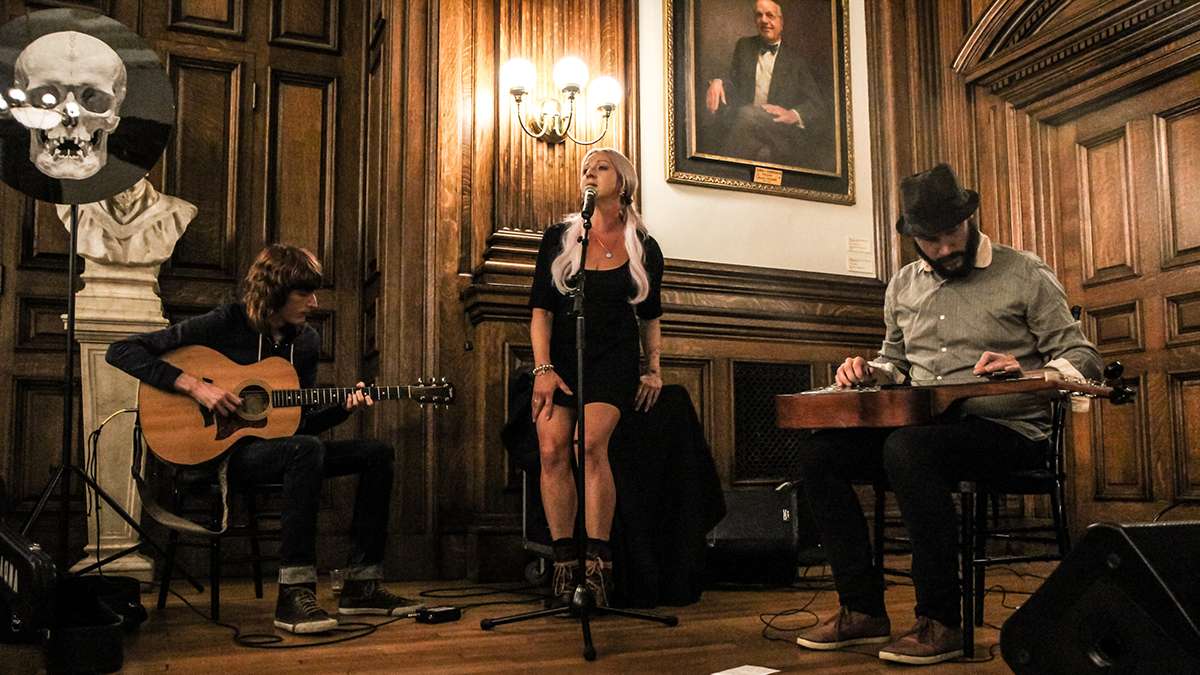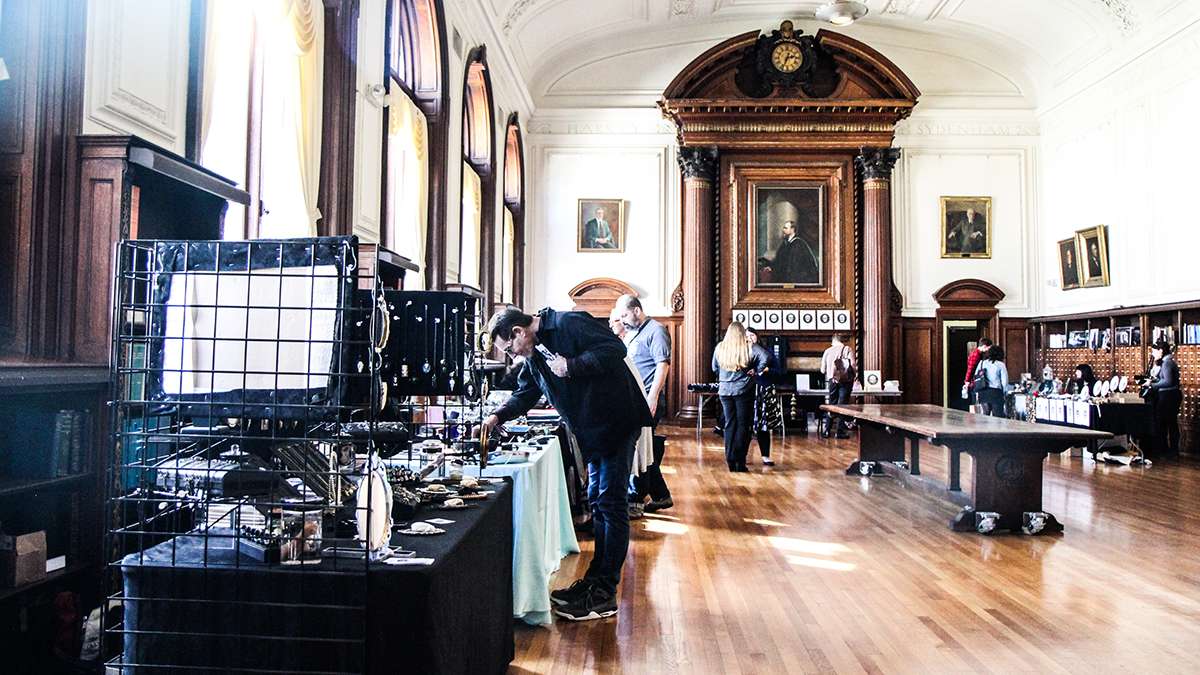From fears to fascinations, what exactly is a death salon?
Listen‘Death geeks’ (yep, that’s a thing) find a home.
Several hundred people from around the world convened in Philadelphia for a rather unusual conference in early October: a death salon. It took place at a grand hall inside Philadelphia’s hallmark museum of medical oddities, the Mütter Museum of the College of Physicians of Philadelphia. The salon has happened in other cities, and many see it as part of a growing “death positive” movement.
Early morning autopsy lessons
A little after 9 a.m., about 200 people sit in rows of cushioned black chairs. They’re mostly wearing black, too, but they all seem to be wide awake, completely engaged with the woman in front. Dr. Marianne Hamel, a medical examiner in Norristown, Pennsylvania, is displaying some straight-up graphic images of autopsied bodies.
“This is a motorcycle victim, actually. What do you think is coming out of his nose? It’s not snot,” she says, waiting for an audience response, and then repeating it. “It’s his brain. Good, excellent…which means he probably has a skull fracture.”
Hamel gives a flash-talk style presentation on the myths and realities of being a medical examiner. She inserts some humor into it. For example, one pet peeve: no, she cannot tell the exact time of a person’s death, unless they were shot in the watch.
Hamel is the very first speaker of this two day death salon.
“Well you know, I’m happy I didn’t eat a big breakfast,” says Jeremy Cohen, who traveled in from Montreal, Canada to attend. “It was jarring but it was a nice way to set the tone for the day.”
Cohen is a grad student, studying Western death rituals, religion and technology. On a personal and academic and level, he’s curious about it all. And he’s in good company, because this is an event for the self-described “death geek.”
Calling all “death geeks”
“I’m a death enthusiast,” says Lori Zaspel of Philadelphia, who’s pursuing a social work degree in dying and bereavement. “We’re all going to die. I think that’s interesting, and I think it’s a shame we don’t talk about that before we die. There are so many instances where people’s wishes aren’t carried out. I don’t think it needs to be avoided.”
Anne Noble, a designer from Michigan, has a table outside the main space, where she’s displaying artist-made urns and even raffling one off. She’s situated near vendors selling everything from crystal crowns to macabre photographs. There’s a women nearby with consumer information about funeral planning and “death midwives.”
“This is a blast. This is awesome,” says Noble, as people peruse her table during a midday break.
Noble’s own family has been in the funeral business for generations. Her grandfather had a horse-an-carriage hearse in South Dakota in the mid 1800s. Even though an event like this is upbeat, Noble says it’s not making light of death.
“This isn’t about vampires and fangs. It’s about professionals who care about what they’re doing and making a different for people,” she says.
Her display is a hit with Michael Fannin, who interacts with urns in a different way.
“Well, I have to be careful when setting stone in ground not to hit the urn in the ground if it was there before I got there,” he tells Noble. “Especially ceramic.”
Fannin’s a traditional gravestone carver from Vermont who’s here to network with others in the industry. Then there’s Sarah Buchmann, a writer from Zurich, Switzerland. She’s wearing a black T-shirt that has the phrase “death positive” printed in big letters on it.
“It means I welcome death into my life, because it makes me aware that I don’t have all the time in the world, and it makes me appreciate every moment,” Buchmann explains.
This is Buchmann’s second death salon.
Defining “death positive”
Many credit the death salon founders, like the MC Caitlin Doughty, with popularizing that phrase and cultivating a death positive community.
“For me it’s like a huge movement!” says Doughty, acknowledging that she’s too involved to really know how big it is.
Doughty, who has bone-straight dark hair and thick bangs, is a mortician and self described death advocate based in Los Angeles, California. She says “death positive” is not to be mistaken as making light of death, or viewing it as positive.
“We’re not talking about when your father dies, just be positive about it…That’s not what we’re saying at all,” she says.
For her, death positivity is about encouraging more openness around death, acknowledging the fears and fascinations.
“Death is the driving force of everything that we do in our culture. It’s why we create art, it’s where history comes from, it’s where science comes from,” she says. “And so it’s a positive thing to understand what an important role that death plays in our lives. And if we’re not doing that then we’re not fully understanding our lives.”
Cultivating a death-positive community
Doughty says people are craving more substantial information about death, but it’s often hard to get. She saw this firsthand when her low-budget YouTube series, Ask-a-Mortician, became an internet sensation overnight.
It’s a simple premise. People ask her questions about death and the funeral business. How long does rigor mortis last? What type of bio safety procedures do morticians use? She does her best to answer them.
“I don’t think there’s any other culture in the world that has quite the distance from the dead human body as we do in the United States…in Western culture,” she says.
Doughty has always had a fascination with death, but she first realized the extent of this disconnect and even denial in Western culture while working in a crematorium in her early 20s.
“I don’t think I knew what a lonely, almost industrial job it is to work at a modern crematory,” she recalls. “You’re there by yourself doing 6 to 7 bodies a day. It’s sometimes a loud environment, sometimes a dirty environment. And there were no family there. It was just me. That was the most shocking part.”
She’d meet families wanting to get more involvement, but not knowing how.
Doughty is quick to point out that this isolation from loved ones wasn’t always the case. The traditional American funeral was one that took place at home. Family handled the body and its burial. Practices started to change during the civil war. That’s when preserving and embalming bodies emerged with soldiers being transported back home. As people moved to cities in the twentieth century, the funeral home increasingly became the center of overseeing the body.
The birth of the death salon
A few years ago, Doughty connected with friends and colleagues—librarians, artists, and death professionals—who, like her, wanted to change the discourse around death. This was amid a growing natural burial movement and the emergence of death cafes. They formed a group called The Order of the Good Death.
“It’s supposed to be somewhat campy, but it actually comes from a Brazilian group of nuns who would take care of dead,” she says. “Throughout history, it’s been of incredible value to speak openly about death and learn how to die well.”
Out of that came the death salon, an actual space for people interested in this notion of death positivity to interact and explore their mortality through sharing knowledge and art.
“One of the most unique aspects for me of it, and something a lot of us take away is the sense of community,” says Sarah Troop, a museum curator and member of the Order of the Good Death. Troop also gave a talk about the rituals surrounding child death in Mexico and Latin America.
Salon is a throwback to the 18th century French salon, where people from different backgrounds would meet to discuss ideas. It explains why, after that 9:00 a.m. forensic pathologist presentation, people heard about everything from the art of preparing skeletal remains to a doctor’s challenges coordinating palliative care for her own mother to a session on preserving transgender identity after death to a live performance and analysis of murder ballads.
The first salon took place in L.A. in 2013. This one in Philadelphia marks the fifth.
A new trend?
“Death positive” may not be a widely recognized phrase, but Anne Esacove, a sociologist at Muhlenberg College and at the University of Pennsylvania, thinks “there is something bigger going on.”
Escove has been researching present-day activities that are trying to change the meaning of death, like smaller, facilitated events often among strangers to discuss death called death cafes, as well as a growing home funeral and green burial movement. Esacove sees death positive as a fairly recent term and movement, at least in its present form. She’s she’s not sure how big it is, but she sees it as tapping into something.
“I do think this is a concerted effort to change experiences with death, even coming out of hospice movement, and now getting more conversations going with health reform and thinking about end of life care…it’s just been kind of snowballing into after death,” she says.
Hospice is the now accepted idea of comfort care for someone with a terminal illness that started gaining traction in the 70s and 80s. An aging baby boomer population has also increased the national focus on advanced care planning and end-of-life care.
Doughty points to other “cultural cornerstones” that are shifting the national conversation around death, such as the publishing of Atul Gawande’s popular book Being Mortal: Medicine and What Matters in the End.
Others view the present day “death positive” movement as a “third wave,” building on similar moments in the 70s and 80s.
Esachove finds the death salon and its death positive culture especially interesting in that it draws a younger crowd. And while there are intimate conversations happening about death and dying, this is an event that goes beyond the individual.
“It really feels different, because it really is about looking culturally and socially about constructions around death, and so i’m really struck by that,” she says.
Parting ways
The salon wraps up with Doughty leading a live, “Ask A Mortician” session with fellow mortician, Sheri Booker.
Throughout the event, Doughty encouraged those with questions, “even weird ones,” to anonymously place them in a designated box.
Early on in the event, Doughty reads this card: “Have you ever dropped a body? Many details, please.”
The room laughs. Other questions are deeper, almost philosophical, like how do you talk to children about death?
When it’s over, Sarah Buchmann, the writer from Zurich wearing a death positive T-shirt, doesn’t want to leave.
“I’m sad I can’t come here tomorrow,” she says.
Buchmann was so inspired after attending the death salon in London, she formed a death cafe, the first in Zurich, to keep the conversation going.
“I try to live by this anyway, but being here really affirmed idea of enjoy life while you have it,” says David Orr, an artist fascinated with skulls, who’s headed back to L.A.
Doughty admits that spending two days pondering death with fellow “death nerds” doesn’t make death any less scary.
She’s ok with that.
“If anybody tells you I’m totally cool with death, doesn’t bother me, I don’t believe them,” she says, “because if you’ve ever really faced own death, your man trembling at the edge of the mountain, it’s terrifying. And every human has the journey of coming to terms with their own mortality, and it’s a journey that lasts their whole life.”
For her, cultivating a death positive community here marks an important part of that journey.
WHYY is your source for fact-based, in-depth journalism and information. As a nonprofit organization, we rely on financial support from readers like you. Please give today.











